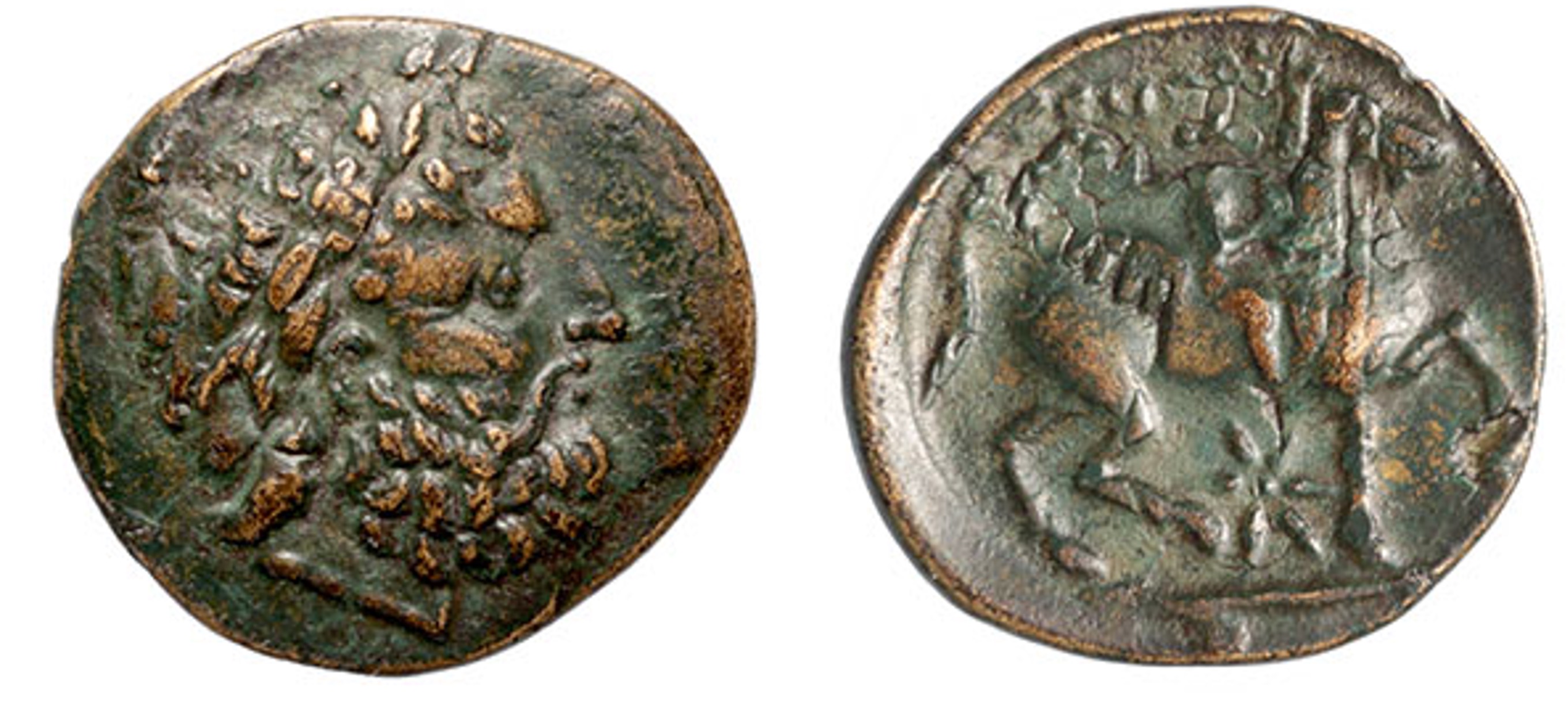3195 - Seuthopolis (Seuthes III) (AE Seuthes/rider) over Cassander (Heracles/lion) (Waddell, LLD, 45542): Difference between revisions
From SILVER
No edit summary |
No edit summary |
||
| Line 19: | Line 19: | ||
|Overstruck ancient region=Pontus | |Overstruck ancient region=Pontus | ||
|Overstruck authority=Lysimachus (Macedonian officer, diadochus and king, c. 360-281 BC) | |Overstruck authority=Lysimachus (Macedonian officer, diadochus and king, c. 360-281 BC) | ||
|Remarks=There is a very clear impression of the under-type on the reverse which is the forepart of a lion from a bronze coin of Lysimachus. The under type must have been struck early in Lysimachus' reign based on the generally accepted dating for Seuthes' reign. | |||
}} | }} | ||
Revision as of 23:50, 1 June 2023
317 BCE - 305 BCE | ΣΕΥΘΟΥ
Location/history
| Sale(s)Sale(s) ᵖ: | Edward J. Waddell, LLD, lot 45542. | |
Overstriking coin
Description
| ObverseInscription or printing placed on the obverse.: | Male head (Zeus? Seuthes?) right, wearing laurel wreath. | ReverseInscription or printing placed on the reverse.: | ΣΕΥΘΟΥ (Greek) Horsman (Seuthes?) riding to right. Below, star. |
Mint and issuing power
| MintIdentifies the place of manufacture or issue of a numismatic object.: | Seuthopolis | Ancient regionAncient region. | Thrace | Modern countryModern country: Bulgaria | AuthorityIdentifies the issuing power. The authority can be "pretended" when the name or the portrait of X is on the coin but he/she was not the issuing power. It can also be "uncertain" when there is no mention of X on the coin but he/she was the issuing power according to the historical sources: | Seuthes III (king of the Odrysian kingdom, c. 331-300 BC) |
Chronology
| FromIdentifies the initial date in a range assigned in a numismatic context. 317 BCE toIdentifies the final date in a range assigned in a numismatic context.. 305 BCE | Hellenistic 323-30 BC |
Physical description
| MetalThe physical material (usually metal) from which an object is made.: Bronze |
WeightWeight of the numismatic object (in grams). in grams: 2.752.75 g <br />2,750 mg <br /> | ||
| DiameterDescribes diameter of an object (in mm).: 1919 mm <br />1.9 cm <br /> | |||
References
| Coin referenceReference of the Coin: | Coin series referenceReference to coin series study: | SNG Stancomb1SNG Stancomb, n° 294., HGC 3.22HGC 3.2, n° 1714 |
Overstruck type
Description
| ObverseInscription or printing placed on the obverse.: | ReverseInscription or printing placed on the reverse.: | Lion resting right. |
Mint and issuing power
| MintIdentifies the place of manufacture or issue of a numismatic object. ᵖ: | Ancient regionAncient region. ᵖ | Pontus | Modern countryModern country: | AuthorityIdentifies the authority in whose name (explicitly or implicitly) a numismatic object was issued. ᵖ: | Lysimachus (Macedonian officer, diadochus and king, c. 360-281 BC) |
Chronology
| FromIdentifies the initial date in a range assigned in a numismatic context. toIdentifies the final date in a range assigned in a numismatic context.. | periodTime period of the numismatic object. |
Physical description
References
| Coin type referenceReference to coin series study ᵖ: |
Additional data
| Frequency of overstrikesFrequency of overstrikes: | Level of confidenceLevel of confidence of the identification: | ||
| RemarksRemarks: | There is a very clear impression of the under-type on the reverse which is the forepart of a lion from a bronze coin of Lysimachus. The under type must have been struck early in Lysimachus' reign based on the generally accepted dating for Seuthes' reign. | ||
